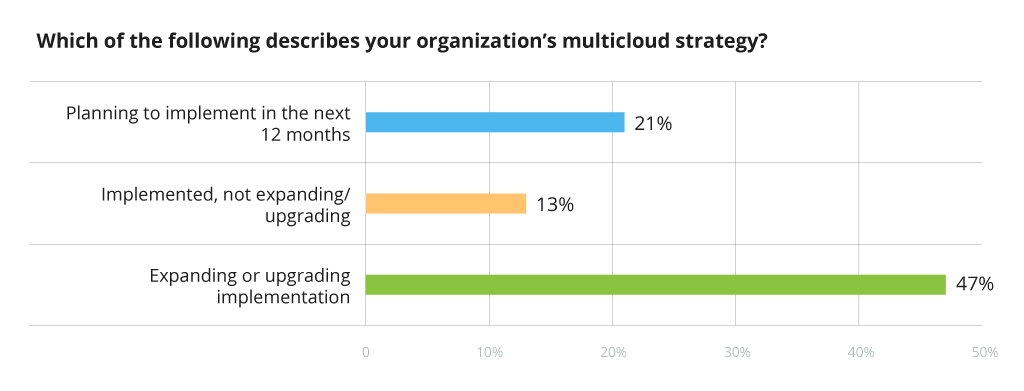Cloud-Agnostic Strategy: What’s in and How to Act to Get Tangible Business Value
Today, about 60% of tech leaders and decision-makers rely on multi-cloud to perform their key workflows. Furthermore, this number is projected to grow to 81% within the next year. Moreover, 90% of the enterprises state that their multi-cloud strategy helped them reach their main business goals.
The State of Multi-Cloud Adoption
What does it feel to be cloud agnostic? Why do enterprises incorporate cloud-agnostic architecture into their IT and business landscape? How to leverage the best of this approach and seamlessly address all the related risks and challenges? Read on to find out the answers.
The Pros of Using the Cloud-Agnostic Paradigm
Independence from a Single Vendor
As opposed to a multi-cloud model, where organizations use multiple cloud services but can’t smoothly shift their workloads from one provider to another, the cloud-agnostic approach offers the possibility of seamless workload migration among providers.
In other words, being cloud-agnostic means having vendor independence. This is a considerable benefit, as according to Bain & Company, 22% of businesses leveraging cloud are concerned with vendor lock-in.
This concern isn’t groundless. There are multiple cases when companies are experiencing downtime due to vendor lock-in. For example, in 2013, Nirvanix, a U.S-based cloud data storage provider went bust, forcing its customers to rapidly transfer all their data out of the provider’s facilities.
Being exempt from vendor lock-in means considerable flexibility and business continuity in the situations when cloud providers encounter security and performance problems, alter their business model and offerings, or significantly and unexpectedly increase their pricing.
Moreover, adopting cloud-agnostic architecture means being able to scale faster and more efficiently. Having such availability of cloud providers, you can move your applications to various servers as well as leverage an array of powerful capabilities from multiple public and private cloud platforms. With such a comprehensive scalability strategy in place, you’re several steps ahead of your competitors that operate on just one cloud platform.
Little to No Downtime
Disruptions and downtimes are the things that always slow down business growth and in turn lead to substantial client and revenue losses. A recent survey from Uptime shows that 80% of data center managers suffered from outages in the past three years, with more than 60% of failures resulting in at least $100,000 in total losses.
With a cloud-agnostic strategy, businesses can make sure their applications and business processes won’t experience any decline in performance and efficiency. Why? Because they’re empowered to choose among multiple cloud vendors when an issue occurs.
Vendor’s outage, security breaches, total performance degradation — no matter what the issue might be — adopters of the cloud-agnostic approach can timely, securely, and flawlessly move their workloads, while maintaining business continuity.
Incorporation of Multiple Features
A great variety of value-rich features offered by multiple providers is another reason to strive for a cloud-agnostic paradigm. When your business is cloud-agnostic, you have the possibility to cherry-pick the best of each cloud vendor — all to successfully address niche-specific business needs.
Data collection and storage, sophisticated analytics and detailed report generation, digital collaboration functionality, rock-solid data security tools — you can use the whole bunch of innovative resources and cloud transformation opportunities from different vendors to reinforce your business.
In addition, by leveraging exclusive vendor features in this way, you can jump ahead of your competitors who don’t rely on multi-cloud. This means a level-up in innovating, operating, and engaging with customers.
Customization for Tailoring Specific Requests
No matter how efficient and multi-purpose a cloud application might be, there’s always room for improvement. Better security, more advanced features, enhanced performance — these and many other crucial aspects can be improved through customization.
A cloud-agnostic approach not only allows you to make the most of your cloud vendors’ services, but also reinforce them in a number of ways.
First, as cloud providers offer utmost flexibility, you can adjust particular applications as per specific requirements your niche dictates. Second, with such flexibility, you can easily and securely scale your cloud infrastructure as your business grows. Third, you can rely on cloud-agnostic interoperability and portability to integrate vendor applications with in-house or third-party solutions via APIs or custom connectors.
Such multiple customization options make part of another valuable benefit of the cloud-agnostic strategy. As a result, businesses are empowered to fortify their products and services, getting a competitive advantage over other industry players.
Key Risks and Challenges of Going Cloud-Agnostic
Any business and tech approach has a reverse side, and the cloud-agnostic model is no exception. However, by partnering with an experienced software developer like Infopulse, you can easily address all the relevant challenges.
Security
One of the most common concerns about adopting a cloud-agnostic strategy is security. As the application logic is on the vendor’s side, cloud applications might be vulnerable to breaches, and as result, to substantial reputational and financial losses.
To mitigate this risk, you need to ensure an extra layer of security — whether in house or through a reliable IT vendor who is in the loop about all the nuances related to cloud security.
A case in point: Infopulse helped one of the leading telecommunication service providers in Ukraine upgrade their business workflows by migrating the outdated IT infrastructure to a modern Microsoft Azure Cloud platform. Particular attention was paid to security, namely using sophisticated cloud cybersecurity solutions. By implementing an S2S VPN network together with conditional access for multi-factor application usage outside of the corporate infrastructure, Infopulse’s specialists minimized potential security risks and strengthened the overall information security for the client.
Complexity and Cost
Building and implementing an agnostic cloud strategy from the ground up is not as easy as it seems. Whether you need it for specific workloads or for the entire enterprise, be ready for significant initial investments and complex development mechanisms.
If you don’t have the right tech and strategic talent in house, you should consider the assistance of adept cloud development specialists. They will thoroughly analyze your business case to develop a tailored cloud-agnostic strategy — with total cost of ownership minimization, enhanced security, and business continuity in mind.
A case in point: Infopulse helped a notable Nordic logistics and supply chain company with digital transformation through infrastructure migration to the cloud. Before the very implementation, the company’s analysts performed a detailed cloud-readiness assessment that included a full-fledged analysis of the existing environment, architecture design proposal, and cost changes scope. As a result, the client got full business automation, uninterrupted service with 99.9% infrastructure availability, revamped collaboration between teams, improved efficiency, and cost optimization.
Unexpected Shutdowns
When utilizing multiple platforms as part of a cloud-agnostic strategy, you have the risk of one of them shutting down and hampering your operations. As we’ve already mentioned earlier, in this situation you can rapidly switch to another cloud provider within your multi-cloud environment. This is a great way out. However, if you want to react even faster to possible issues and bring downtime to zero, capitalize on advanced analytics.
As an experienced managed cloud services provider, Infopulse can provide you with 24/7 monitoring of your cloud workloads to ensure their continuous performance.
Key Techs and Tools for Cloud-Agnostic Strategy Implementation
If you opt to go cloud-agnostic and want your strategy to be a success, consider these important aspects:
- Automation. Use the best DevOps practices like CI/CD, Infrastructure as Code, ITIL, DevSecOps, and more to enable automation early in the process. This way, you’ll be able to easily scale your applications with little manual effort in the future. The automate-first mentality powered by application performance management will also allow you to significantly improve troubleshooting as well as predict previously unknown anomalies and issues.
- Microservices and containers. Run within containers, microservices enable swift and reliable implementation of complex applications, never-before-seen flexibility, on-demand scalability, resiliency, and robust security. The most relevant tools to manage effectively containerized workloads include Docker, Nomad, and Kubernetes.
- Managed databases. By using managed database services from major cloud providers like AWS, Google, and Microsoft Azure, you can easily manage the highest volume workloads and smoothly migrate them between providers — with automatic patching and upgrades, backups and failover, as well as high availability and durability.
- Agile development. Underpinned by the Agile approach, you can re-use policies and services across the whole multi-cloud environment. This will help you standardize and simplify the entire deployment process, while ensuring consistency in performance and security.
What’s Next?
As we’ve found out, choosing a cloud-agnostic road is the right decision if you want to rapidly adapt to a dynamic IT environment as well as to constantly rising market and customer demands. An expert in cloud development, Infopulse is ready to deliver their experience and insight in this domain.
![Benefits of Cloud-Agnostic Strategy [banner]](https://www.infopulse.com/uploads/media/banner-1920x528-cloud-agnostic-strategy-whats-in-and-how-to-act-to-get-tangible-business-value.webp)



![Cloud-Native for Banking [thumbnail]](/uploads/media/cloud-native-solutions-for-banking_280x222.webp)
![Generative AI and Power BI [thumbnail]](/uploads/media/thumbnail-280x222-generative-AI-and-Power-BI-a-powerful.webp)
![Cloud Native vs. Cloud Agnostic [thumbnail]](/uploads/media/thumbnail-280x222-cloud-agnostic-vs-cloud-native-architecture-which-approach-to-choose.webp)
![DevOps Adoption Challenges [thumbnail]](/uploads/media/thumbnail-280x222-7-devops-challenges-for-efficient-adoption.webp)
![Azure Monitor for SAP [thumbnail]](/uploads/media/thumbnail-280x222-azure-monitor-for-sap-solutions-an-overview.webp)

![Mortgages Module Flexcube [Thumbnail]](/uploads/media/thumbnail-280x222-Secrets-of-setting-up-a-mortgage-module-in-Oracle-FlexCube.webp)
![Digital Alignment Drivers [thumbnail]](/uploads/media/thumbnail-280x222-the-top-forces-driving-digital-alignment.webp)
![AWS vs. Azure Cloud Platform [Thumbnail]](/uploads/media/thumbnail-280x222-comparison-of-aws-vs-azure-when-each-cloud-platform-works-best.webp)
![Cloud-Native Maturity Model Assessment [thumbnail]](/uploads/media/thumbnail-280x222-what-Is-the-cloud-native-maturity-model-definition-and-assessment-criteria.webp)